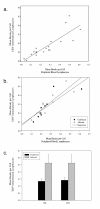Association of Rad51 polymorphism with DNA repair in BRCA1 mutation carriers and sporadic breast cancer risk
- PMID: 21708019
- PMCID: PMC3146938
- DOI: 10.1186/1471-2407-11-278
Association of Rad51 polymorphism with DNA repair in BRCA1 mutation carriers and sporadic breast cancer risk
Abstract
Background: Inter-individual variation in DNA repair capacity is thought to modulate breast cancer risk. The phenotypic mutagen sensitivity assay (MSA) measures DNA strand breaks in lymphocytes; women with familial and sporadic breast cancers have a higher mean number of breaks per cell (MBPC) than women without breast cancer. Here, we explore the relationships between the MSA and the Rad51 gene, which encodes a DNA repair enzyme that interacts with BRCA1 and BRCA2, in BRCA1 mutation carriers and women with sporadic breast cancer.
Methods: Peripheral blood lymphoblasts from women with known BRCA1 mutations underwent the MSA (n = 138 among 20 families). BRCA1 and Rad51 genotyping and sequencing were performed to identify SNPs and haplotypes associated with the MSA. Positive associations from the study in high-risk families were subsequently examined in a population-based case-control study of breast cancer (n = 1170 cases and 2115 controls).
Results: Breast cancer diagnosis was significantly associated with the MSA among women from BRCA1 families (OR = 3.2 95%CI: 1.5-6.7; p = 0.004). The Rad51 5'UTR 135 C>G genotype (OR = 3.64; 95% CI: 1.38, 9.54; p = 0.02), one BRCA1 haplotype (p = 0.03) and in a polygenic model, the E1038G and Q356R BRCA1 SNPs were significantly associated with MBPC (p = 0.009 and 0.002, respectively). The Rad51 5'UTR 135C genotype was not associated with breast cancer risk in the population-based study.
Conclusions: Mutagen sensitivity might be a useful biomarker of penetrance among women with BRCA1 mutations because the MSA phenotype is partially explained by genetic variants in BRCA1 and Rad51.
Figures

Similar articles
-
A single-nucleotide polymorphism in the RAD51 gene modifies breast cancer risk in BRCA2 carriers, but not in BRCA1 carriers or noncarriers.Br J Cancer. 2004 May 17;90(10):2002-5. doi: 10.1038/sj.bjc.6601837. Br J Cancer. 2004. PMID: 15138485 Free PMC article.
-
Chromosomal mutagen sensitivity associated with mutations in BRCA genes.Cytogenet Genome Res. 2004;104(1-4):325-32. doi: 10.1159/000077511. Cytogenet Genome Res. 2004. PMID: 15162060 Review.
-
A single nucleotide polymorphism in the RAD51 gene modifies cancer risk in BRCA2 but not BRCA1 carriers.Proc Natl Acad Sci U S A. 2001 Mar 13;98(6):3232-6. doi: 10.1073/pnas.051624098. Proc Natl Acad Sci U S A. 2001. PMID: 11248061 Free PMC article.
-
Breast cancer risk reduction associated with the RAD51 polymorphism among carriers of the BRCA1 5382insC mutation in Poland.Cancer Epidemiol Biomarkers Prev. 2003 May;12(5):457-9. Cancer Epidemiol Biomarkers Prev. 2003. PMID: 12750242
-
Clinical management of women with genomic BRCA1 and BRCA2 mutations.Breast Cancer Res Treat. 2001 Sep;69(2):101-13. doi: 10.1023/a:1012203917104. Breast Cancer Res Treat. 2001. PMID: 11759816 Review.
Cited by
-
Evaluation of miRNA-binding-site SNPs of MRE11A, NBS1, RAD51 and RAD52 involved in HRR pathway genes and risk of breast cancer in China.Mol Genet Genomics. 2015 Jun;290(3):1141-53. doi: 10.1007/s00438-014-0983-5. Epub 2015 Jan 9. Mol Genet Genomics. 2015. PMID: 25566853
-
BRCA1 polymorphisms and breast cancer epidemiology in the Western New York exposures and breast cancer (WEB) study.Genet Epidemiol. 2013 Jul;37(5):504-11. doi: 10.1002/gepi.21730. Epub 2013 May 14. Genet Epidemiol. 2013. PMID: 23674270 Free PMC article.
-
Identification of Polycomb Group Protein EZH2-Mediated DNA Mismatch Repair Gene MSH2 in Human Uterine Fibroids.Reprod Sci. 2016 Oct;23(10):1314-25. doi: 10.1177/1933719116638186. Epub 2016 Mar 31. Reprod Sci. 2016. PMID: 27036951 Free PMC article.
-
RAD51 polymorphisms and breast cancer risk.Mol Biol Rep. 2013 Jan;40(1):665-8. doi: 10.1007/s11033-012-2105-y. Epub 2012 Oct 13. Mol Biol Rep. 2013. PMID: 23065228
-
Haplotype analyses of DNA repair gene polymorphisms and their role in ulcerative colitis.PLoS One. 2014 Sep 23;9(9):e108562. doi: 10.1371/journal.pone.0108562. eCollection 2014. PLoS One. 2014. PMID: 25247297 Free PMC article.
References
Publication types
MeSH terms
Substances
Grants and funding
LinkOut - more resources
Full Text Sources
Medical
Research Materials
Miscellaneous

